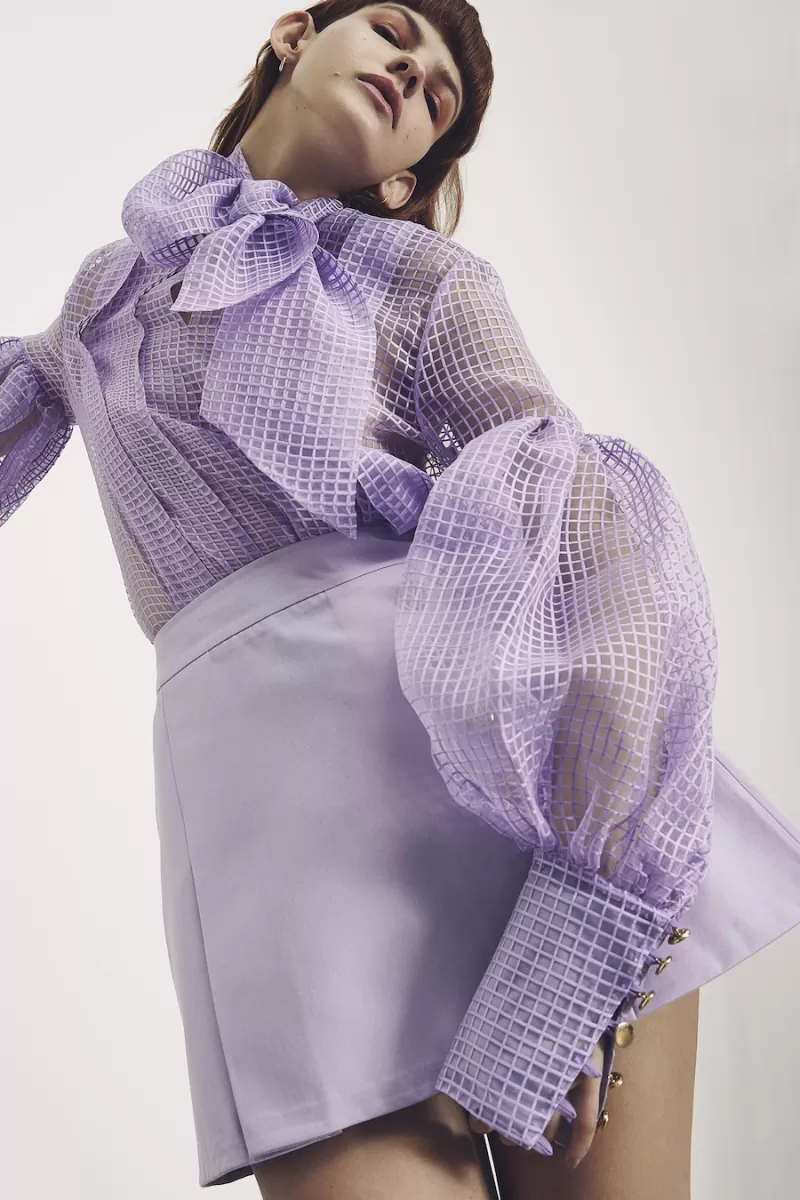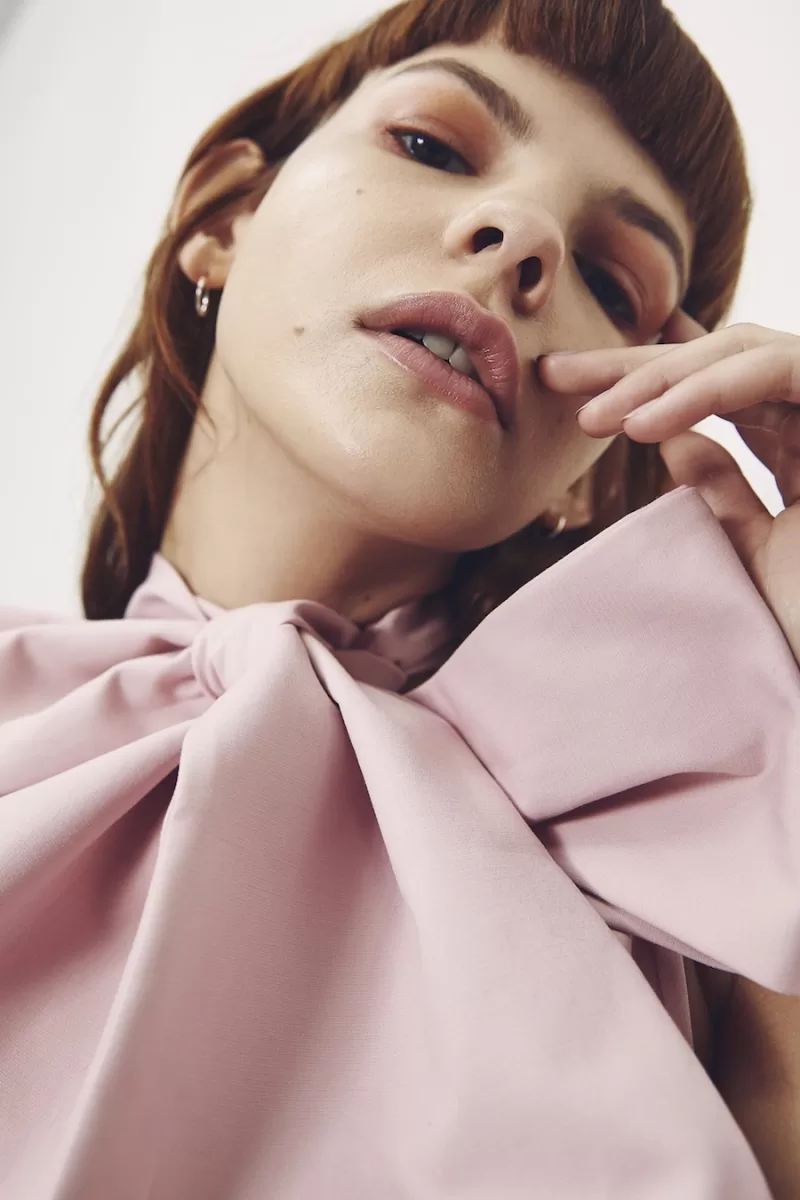Interview – George Keburia

What I love about my home country is that Georgians are fighters, they do not get scared or frustrated easily and they have a huge potential, which they are not using to their full extent
Tbilisi, the town we’re all fixated on for fashion talent – with due thanks to Georgian born and bred disruptor Demna Gvasalia driving collective Vetements – just keeps on giving. One of the latest stars to emerge from the capital’s creative scene is George Keburia, whose name you have probably in the same breath as micro-shades: the movement he’s been spearheading that’s been picked up by the likes of Solange and the Hadid sisters.
Creating an aesthetic he’d rather not talk about as he wants to steer clear of sounding trite and forced on paper, Keburia has slowly been building momentum since he launched his brand in 2010. What’s unique about the designer is that he’s entirely self-taught – he’s never stepped foot inside of a fashion school, instead, following his parents planned trajectory he trained up to work in business management before giving into his real calling to design, which he says he’s mastered through his own mistakes.
At 27, he is part of a wave of Eastern European designers dubbed the ‘New East’ who are generating intrigue on a global scale for their unprecedented approaches to fashion; giving editors a fresh aesthetic to sink their teeth into – and what does the designer make of this? “I consider that we met this interest well prepared and that Georgian designers are doing a good job,” he tells us. And a good use of the spotlight the designer has certainly made. Through his designs he has brought a multitude of socio-political issues to the fore: among them homophobia and the country’s turbulence in the wake of the Georgian civil wars in the 90s. This season, however, the designer looked outside of his stomping ground for a starting point – and to the glamour of Hollywood and American prom’s from the 80s. “I don’t choose source of inspiration,” he explained. “I can get inspiration spontaneously from many different things.”
Read on to hear his thoughts on why fashion will always be an agent of change and a crucial tool to explore social issues, what day-to-day life in Georgia is really like, and the looks you’re likely to brush shoulders with on the streets of Tbilisi.
Tell me about home: your neighbourhood, your friends and the scene.
Despite centuries of history, Georgia has always been undervalued. When I used to say that I am from Georgia, everyone was thinking about the state of USA. This was really annoying because I had to explain that Georgia was also a country, situated in Caucasus region which not so long ago, didn’t even have everyday utilities like electricity, water and gas. But during the last couple of decades everything changed dramatically, as if we have silently decided to come out of the darkness, raise our voices and take our place on the international scene. When it comes to fashion, to me at the moment it is the most promising field in Georgia. During the recent years level of international interest and attention towards Georgian fashion scene has raised dramatically and this makes me extremely happy.
I am extremely lucky to have wonderful friends. One of my closest friends is stylist, Giorgi Wazowski, who is always helping me out with the collections. Also, a Georgian photographer, Louisa Chalatashvili, is my close friend – my Instagram page is literally loaded with her images. My models cast usually includes many of my friends, because they have very unique and interesting appearances.
You’ve become a representative of Georgia today – why do you think there’s such a spotlight on Georgian designers at the moment, and what do you make of the umbrella term the ‘New East’ for Eastern European designers?
Obviously Demna Gvasalia’s huge success turned the spotlight towards Georgia and it’s fashion scene. It might be that editors, journalists and people who work in fashion industry became curious as to whether there are other talented designers to watch out in Georgia. I consider that we met this interest well prepared and that Georgian designers are doing a good job.
What do you love about your home, and what is it that you hope to convey about your heritage through your designs?
What I love about my home country is that Georgians are fighters, they do not get scared or frustrated easily and they have a huge potential, which they are not using to their full extent. However, as in many other countries, there are some issues as well. Georgia is rather conservative and homophobia is a huge problem. I expressed my protest towards this through tops with weapon and word “gay” embroidery. When it comes to my recent collections, they do not carry any specific social message.

How would you describe the Georgian sense of style and how would you say it’s evolved? Talk me through some of the most interesting styles you see on the streets.
Balenciaga and Vêtements are trendsetters, so the young wear replicas of their products and they usually try to follow aesthetic of these brands as much as possible. Basically, Demna Gvasalia’s Balenciaga defined the aesthetic of a generation. He made fashion aesthetic more real, authentic and down to earth. It was a clash of juxtapositions that made little distinctions between the underground and mainstream, kitsch and chic, authentic and fake. Georgians are aware of this. They follow Demna’s aesthetic. When I walk in the streets, I always see someone wearing ugly sneakers, oversized puffer jackets, hoodies or reconstructed jeans. Georgians also try to mash up post-soviet era and underground style, they want to look uber cool without trying and all these things are part of Demna’s aesthetic. Regarding a senior crowd, their outfits can also resemble Balenciaga aesthetics, but this is not because they are following fashion trends, but largely because they are wearing their old clothes, which are literally from soviet era.
When I walk in the streets, I always see someone wearing ugly sneakers, oversized puffer jackets, hoodies or reconstructed jeans. Georgians also try to mash up post-soviet era and underground style, they want to look uber cool without trying and all these things are part of Demna’s aesthetic
You’ve garnered a lot of press in the past for the political undercurrents to your work – why do you think fashion is such an important platform to explore such weighted issues?
Fashion reflects reality, everything that happens in the society, from politics to culture. It is like a mirror portraying bad and good sides of contemporary world. Fashion gives designers a platform to make statements about their affections or disaffections. So, that’s why I consider that fashion is important platform to explore weighted issues.
You’ve said that you feel as though the post-Soviet aesthetic has had it’s time, and it’s clear to see a move away from this in your recent collections. Do you still mine inspiration from traditional Georgian cultural heritage or do you look elsewhere?
Recently, I have been looking through different music videos and images from 80s. My latest collection is all about Hollywood glamour and American prom vibes in 80s. So, this time, I did not take any inspiration from Georgian culture or history. I liked how funky, vibrant and funny the 80s was with its odd style which is tacky, humorous and stylish at the same time. This gave me inspiration and pushed me to reflect same vibe and mood in my recent collection. I have tried to create 80s Hollywood glamour and prom vibes through a mix of colours, fabrics, and textures, as well as oversized accessories. I don’t choose source of inspiration. I can get inspiration spontaneously from many different things, it depends on my factors. It is impossible to plan this process.

An integral part of your designs has been to incorporate aspects that echo the civil conflicts in Georgia in the 1990s, is it hard to escape the shadow of those events in both life and art? Is there a desire among the young gen of Georgians to move away from the country’s turbulent past, or is it honoured as an intrinsic part of the country’s history?
I do not try to escape from the past, because it is already in the past and there is not much you can do about it. As it is said: “what does not kill you, makes you stronger”. I think that past gives us courage and motivation for present and future endeavours. Reflecting social issues in art is sometimes inevitable because our daily life is so influenced by those things. Fashion, as every other field of art, gives people voice and opportunity to express what they care about, what is important or problematic for them. My AW16 collection partially echoed civil war and turbulent 90s in Georgia. The gun print was used to reflect the difficult and dark times the country went through. On the other hand, the rainbow colours were used to undermine that darkness, and make it more optimistic.
Photographer: Carla Guler
Stylist: Jamie-Maree Shipton
Model: Lena at NEVS
Hair and make up artist: Oonah Anderson
